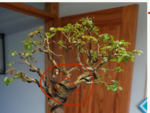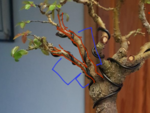You are using an out of date browser. It may not display this or other websites correctly.
You should upgrade or use an alternative browser.
You should upgrade or use an alternative browser.
My two elms alive and well
- Thread starter Bonsai_paul
- Start date
Nanuk
Shohin
Looking good sir.
Shibui
Imperial Masterpiece
Chinese elm are a good choice for beginners. They are tough and can usually survive both accidents and many newbie mistakes. Don't worry though. There are still plenty of opportunities to learn from killing a few trees. Even the most experienced still lose occasional bonsai.
I wonder how long you have to keep them alive before you can really call yourself a bonsai grower?
I wonder how long you have to keep them alive before you can really call yourself a bonsai grower?
markyscott
Imperial Masterpiece
Are you looking for any feedback or suggestions?
- Scott
- Scott
Bonsai_paul
Mame
Always looking for suggestionsAre you looking for any feedback or suggestions?
- Scott
augustine
Chumono
I think you've done a nice job. Good luck
Bonsai_paul
Mame
Thank youI think you've done a nice job. Good luck
markyscott
Imperial Masterpiece
Always looking for suggestions
Great! In that spirit, I’ll offer a couple of observations. This issues I see are common to a lot of trees in development, so I want to share with you what I noted as I looked at your first tree. This is not a big deal, but a couple of tweaks in you how you view training broadleaf trees might help you make a more sophisticated and better developed branch structure. Here’s what I see with the branches on your first tree:

I see a lot of long straight branches with no taper and the only branching is way out at he tips of the branches. There’s some movement, but it’s all gentle curves - no abrupt direction changes that come from cutback. Many interior branches that likely could have been used to correct this appear to have been removed:

There are at least four major structural branches emerging from the same spot on the tree:

This likely cannot be maintained. Eventually it will cause swelling and inverse taper at that point on the tree
From these observations, I’d guess that the practice in developing this tree has been to grow the branches to length, wire in some movement and then begin pinching and removing interior buds. Ultimately this practice will not generate the taper, branching, or movement I’d like to see in more developed specimens - quite the opposite. Instead you’ll get young looking, straight branches with all of the development out at the end of the branch where the pinching has taken place. When trees like this have ended up in my collection, I’ve ended up simply removing most or all of the branches, severely cutting back the remainder and simply starting over again.
Scott
markyscott
Imperial Masterpiece
Let’s focus in on one branch:

What we’d like to see is the branch bifurcating. Then each of the bifurcations dividing and so on down the branch. The space between the trunk and the primary bifurcation should be long and subsequent bifurcations should get progressively closer together. However, in this case there is a very short distance between the trunk and the first branch, a VERY long relative distance between the first bifurcation and the next branching, which is really just twiggy growth. Not really a structural branch at all.

I’d like to see more divisions to make a more interesting structural branch architecture before the twigginess out at the end of the branches.
- S

What we’d like to see is the branch bifurcating. Then each of the bifurcations dividing and so on down the branch. The space between the trunk and the primary bifurcation should be long and subsequent bifurcations should get progressively closer together. However, in this case there is a very short distance between the trunk and the first branch, a VERY long relative distance between the first bifurcation and the next branching, which is really just twiggy growth. Not really a structural branch at all.

I’d like to see more divisions to make a more interesting structural branch architecture before the twigginess out at the end of the branches.
- S
markyscott
Imperial Masterpiece
So what to do? I’d offer you tweak your view about broadleaf branch development recognizing that:
https://www.bonsainut.com/threads/chuhin-broom-elm.22848/
It’s a different style than what you’re going for here, but the principles of branch development are exactly the same. Only now, after 3 years of branch development, can you start to see what the eventual branch structure will look like. Early on - grow and cut back. Later - start pinching and worrying about twigginess at the end of the branches.
Anyway, that’s my 2cents. Hope it helped.
- Scott
- Branches are broadleaf hardwoods are built from the inside out, not the outside in.
- The best way to build strength and girth in your branches is to let them grow
- The best way to build movement and taper in your branches is to cut them back. This will also help with backbudding.
- Wiring in broadleaf hardwoods is really just to establish the primary direction of the branch and to add a little movement while the branches are young. Branch structure on broadleaf hardwoods is mostly built by pruning, not by wiring.
- Early spring work is repotting and cutback. By cutback, I mean cutting back into lignified wood to establish movement, taper and to define where the next branching will occur
- Late spring, early summer work is pruning and wiring. Let the branches grow all spring and early summer. Then select the ones you want to keep and wire them into place and prune away the rest.
- You can repeat 2 several times during the summer. Watch the wiring and remove it as it starts to cut in. Once the branches have grown to the appropriate girth for the next level in the branch structure, you can cut back and start again. This may take more than one growing season if you’re trying to grow big branches on a big tree, but the time will get shorter and shorter as the tree gets more and more developed.
- Pinching
- Leaf selection
- Partial outer canopy defoliation
- Etc
https://www.bonsainut.com/threads/chuhin-broom-elm.22848/
It’s a different style than what you’re going for here, but the principles of branch development are exactly the same. Only now, after 3 years of branch development, can you start to see what the eventual branch structure will look like. Early on - grow and cut back. Later - start pinching and worrying about twigginess at the end of the branches.
Anyway, that’s my 2cents. Hope it helped.
- Scott
@markyscott that's an phenomenal reply wow. Thanks for that
Bonsai_paul
Mame
@markyscott wow thank you for the amazing detailed response and all feedback is noted 
Similar threads
- Replies
- 7
- Views
- 390



